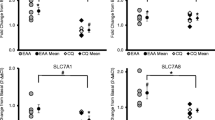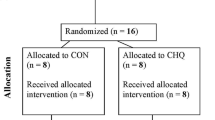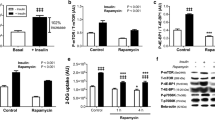Abstract
The essential amino acids (EAA) activate anabolic signalling through mechanisms, which are unclear in detail but include increased signalling through the mammalian target of rapamycin complex 1 (mTORC1). Of all the EAA, the branched chain amino acid (BCAA) leucine has been suggested as the most potent in stimulating protein synthesis, although there have been no studies investigating the effects of each EAA on anabolic signalling pathways. We therefore undertook a systematic analysis of the effect of each EAA on mTORC1 signalling in C2C12 myotubes whereby cells were serum (4 h) and amino acid (1 h) starved before stimulation with 2 mM of each amino acid. Immunoblotting was used to detect phosphorylated forms of protein kinase B (Akt)/mTORC1 signalling enzymes. The phosphorylation of Akt was unchanged by incubation with EAA. Phosphorylation of mTOR and 4E binding protein-1 (4EBP1) were increased 1.67 ± 0.1-fold and 2.5 ± 0.1-fold, respectively, in response to leucine stimulation but not in response to any other EAA. The phosphorylation of ribosomal s6 kinase (p70S6K1) was increased by stimulation with all EAA with the exceptions of isoleucine and valine. However, the increase with leucine was significantly greater, 5.9 ± 0.3-fold compared to 1.6–2.0-fold for the non-BCAA EAA. This pattern of activation was identical in ribosomal protein s6 (RPS6) with the additional effect of leucine being 3.8 ± 0.3-fold versus 1.5–2.0-fold. Phosphorylation of eukaryotic initiation/elongation factors eIF2α and eEF2 were unaffected by EAA. We conclude that leucine is unique amongst the amino acids in its capacity to stimulate both mTOR and 4EBP1 phosphorylation and to enhance p70S6K1 signalling.



Similar content being viewed by others
References
Anthony JC, Anthony TG, Kimball SR, Vary TC, Jefferson LS (2000a) Orally administered leucine stimulates protein synthesis in skeletal muscle of postabsorptive rats in association with increased eIF4F formation. J Nutr 130:139–145
Anthony JC, Yoshizawa F, Anthony TG, Vary TC, Jefferson LS, Kimball SR (2000b) Leucine stimulates translation initiation in skeletal muscle of postabsorptive rats via a rapamycin-sensitive pathway. J Nutr 130:2413–2419
Atherton PJ, Szewczyk N, Selby A, Rankin D, Hillier K, Smith K, Rennie M, Loughna P (2009) Cyclic stretch reduces myofibrillar protein synthesis despite increases in FAK and anabolic signalling in L6 cells. J Physiol 587(Pt 14):3719–3727
Balage M, Sinaud S, Prod’homme M, Dardevet D, Vary TC, Kimball SR, Jefferson LS, Grizard J (2001) Amino acids and insulin are both required to regulate assembly of the eIF4E•eIF4G complex in rat skeletal muscle. Am J Physiol Endocrinol Metab 281:E565–E574
Beugnet A, Tee AR, Taylor PM, Proud CG (2003) Regulation of targets of mTOR (mammalian target of rapamycin) signalling by intracellular amino acid availability. Biochem J 372(Pt 2):555–566
Bohe J, Low A, Wolfe RR, Rennie MJ (2003) Human muscle protein synthesis is modulated by extracellular, not intramuscular amino acid availability: a dose-response study. J Physiol 552:315–324
Bolster DR, Vary TC, Kimball SR, Jefferson LS (2004) Leucine regulates translation initiation in rat skeletal muscle via enhanced eIF4G phosphorylation. J Nutr 134:1704–1710
Buse MG, Reid SS (1975) Leucine. A possible regulator of protein turnover in muscle. J Clin Invest 56:1250–1261
Byfield MP, Murray JT, Backer JM (2005) hVps34 is a nutrient-regulated lipid kinase required for activation of p70 S6 kinase. J Biol Chem 280:33076–33082
Christie GR, Hajduch E, Hundal HS, Proud CG, Taylor PM (2002) Intracellular sensing of amino acids in Xenopus laevis oocytes stimulates p70 S6 kinase in a target of rapamycin-dependent manner. J Biol Chem 277:9952–9957
Copp J, Manning G, Hunter T (2009) TORC-specific phosphorylation of mammalian target of rapamycin (mTOR): phospho-Ser2481 is a marker for intact mTOR signaling complex 2. Cancer Res 69:1821–1827
Eckert-Boulet N, Larsson K, Wu B, Poulsen P, Regenberg B, Nielsen J, Kielland-Brandt MC (2006) Deletion of RTS1, encoding a regulatory subunit of protein phosphatase 2A, results in constitutive amino acid signaling via increased Stp1p processing. Eukaryot Cell 5:174–179
Escobar J, Frank JW, Suryawan A, Nguyen HV, Kimball SR, Jefferson LS, Davis TA (2005) Physiological rise in plasma leucine stimulates muscle protein synthesis in neonatal pigs by enhancing translation initiation factor activation. Am J Physiol Endocrinol Metab 288:E914–E921
Escobar J, Frank JW, Suryawan A, Nguyen HV, Davis TA (2007) Amino acid availability and age affect the leucine stimulation of protein synthesis and eIF4F formation in muscle. Am J Physiol Endocrinol Metab 293:E1615–E1621
Findlay GM, Yan L, Procter J, Mieulet V, Lamb RF (2007) A MAP4 kinase related to Ste20 is a nutrient-sensitive regulator of mTOR signalling. Biochem J 403:13–20
Fulks RM, Li JB, Goldberg AL (1975) Effects of insulin, glucose, and amino acids on protein turnover in rat diaphragm. J Biol Chem 250:290–298
Garlick PJ, Grant I (1988) Amino acid infusion increases the sensitivity of muscle protein synthesis in vivo to insulin. Effect of branched-chain amino acids. Biochem J 254:579–584
Holz MK, Blenis JJ (2005) Identification of S6 kinase 1 as a novel mammalian target of rapamycin (mTOR)-phosphorylating kinase. J Biol Chem 280(28):26089–26093
Jefferies HB, Reinhard C, Kozma SC, Thomas G (1994) Rapamycin selectively represses translation of the “polypyrimidine tract” mRNA family. Proc Natl Acad Sci USA 91:4441–4445
Kim E, Goraksha-Hicks P, Li L, Neufeld TP, Guan KL (2008) Regulation of TORC1 by Rag GTPases in nutrient response. Nat Cell Biol 10(8):935–945
Kimball SR, Shantz LM, Horetsky RL, Jefferson LS (1999) Leucine regulates translation of specific mRNAs in L6 myoblasts through mTOR-mediated changes in availability of eIF4E and phosphorylation of ribosomal protein S6. J Biol Chem 274:11647–11652
Nobukuni T, Joaquin M, Roccio M, Dann SG, Kim SY, Gulati P, Byfield MP, Backer JM, Natt F, Bos JL, Zwartkruis FJ, Thomas G (2005) Amino acids mediate mTOR/raptor signaling through activation of class 3 phosphatidylinositol 3OH-kinase. Proc Natl Acad Sci USA 102:14238–14243
Norton LE, Layman DK, Bunpo P, Anthony TG, Brana DV, Garlick PJ (2009) The leucine content of a complete meal directs peak activation but not duration of skeletal muscle protein synthesis and mammalian target of rapamycin signaling in rats. J Nutr 139:1103–1109
Peyrollier K, Hajduch E, Blair AS, Hyde R, Hundal HS (2000) L-leucine availability regulates phosphatidylinositol 3-kinase, p70 S6 kinase and glycogen synthase kinase-3 activity in L6 muscle cells: evidence for the involvement of the mammalian target of rapamycin (mTOR) pathway in the L-leucine-induced up-regulation of system A amino acid transport. Biochem J 350(Pt 2):361–368
Raught B, Peiretti F, Gingras AC, Livingstone M, Shahbazian D, Mayeur GL, Polakiewicz RD, Sonenberg N, Hershey JW (2004) Phosphorylation of eucaryotic translation initiation factor 4B Ser422 is modulated by S6 kinases. EMBO J 23(8):1761–1769
Roux PP, Shahbazian D, Vu H, Holz MK, Cohen MS, Taunton J, Sonenberg N, Blenis JJ (2007) RAS/ERK signaling promotes site-specific ribosomal protein S6 phosphorylation via RSK and stimulates cap-dependent translation. J Biol Chem 282(19):14056–14064
Ruvinsky I, Sharon N, Lerer T, Cohen H, Stolovich-Rain M, Nir T, Dor Y, Zisman P, Meyuhas O (2005) Ribosomal protein S6 phosphorylation is a determinant of cell size and glucose homeostasis. Genes Dev 19(18):2199–2211
Sancak Y, Thoreen CC, Peterson TR, Lindquist RA, Kang SA, Spooner E, Carr SA, Sabatini DM (2007) PRAS40 is an insulin-regulated inhibitor of the mTORC1 protein kinase. Mol Cell 25:903–915
Sancak Y, Peterson TR, Shaul YD, Lindquist RA, Thoreen CC, Bar-Peled L, Sabatini DM (2008) The Rag GTPases bind raptor and mediate amino acid signaling to mTORC1. Science 320:1496–1501
Shigemitsu K, Tsujishita Y, Miyake H, Hidayat S, Tanaka N, Hara K, Yonezawa K (1999) Structural requirement of leucine for activation of p70 S6 kinase. FEBS Lett 447:303–306
Smith K, Barua JM, Watt PW, Scrimgeour CM, Rennie MJ (1992) Flooding with l-[1–13C]leucine stimulates human muscle protein incorporation of continuously infused l-[1–13C]valine. Am J Physiol 262:E372–E376
Smith K, Reynolds N, Downie S, Patel A, Rennie MJ (1998) Effects of flooding amino acids on incorporation of labeled amino acids into human muscle protein. Am J Physiol 275:E73–E78
Tipton KD, Gurkin BE, Matin S, Wolfe RR (1999) Nonessential amino acids are not necessary to stimulate net muscle protein synthesis in healthy volunteers. J Nutr Biochem 10:89–95
Vary TC, Anthony JC, Jefferson LS, Kimball SR, Lynch CJ (2007) Rapamycin blunts nutrient stimulation of eIF4G, but not PKCepsilon phosphorylation, in skeletal muscle. Am J Physiol Endocrinol Metab 293:E188–E196
Wang X, Li W, Williams M, Terada N, Alessi DR, Proud CG (2001) Regulation of elongation factor 2 kinase by p90(RSK1) and p70 S6 kinase. EMBO J 20(16):4370–4379
Yoshizawa F, Sekizawa H, Hirayama S, Yamazaki Y, Nagasawa T, Sugahara K (2004) Tissue-specific regulation of 4E-BP1 and P70S6K1 phosphorylation by alpha-ketoisocaproate. J Nutr Sci Vitaminol (Tokyo) 50:56–60
Acknowledgments
P. J. Atherton is a designated Research Councils UK Fellow. T. Etheridge is supported by an Medical Research Council grant (G0801271) and D. Rankin by grants from the Biotechnology and Biological Sciences Research Council (BB/X510697/1 and BB/C516779/1), and EC EXEGENESIS.
Author information
Authors and Affiliations
Corresponding author
Rights and permissions
About this article
Cite this article
Atherton, P.J., Smith, K., Etheridge, T. et al. Distinct anabolic signalling responses to amino acids in C2C12 skeletal muscle cells. Amino Acids 38, 1533–1539 (2010). https://doi.org/10.1007/s00726-009-0377-x
Received:
Accepted:
Published:
Issue Date:
DOI: https://doi.org/10.1007/s00726-009-0377-x




